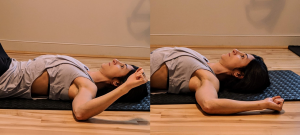The glenohumeral (shoulder) joint requires balanced and adequate external rotation to perform a pull-up effectively. Assessing the performance of both internal and external rotator muscles will address mobility issues first so that progressions are successful and strength gains occur.
Three areas in which assessing and improving mobility will impact the ability to perform pull-ups effectively:
1) Thoracic spine mobility coupled with latissimus dorsi length
2) Scapular upward/downward rotation
3) Glenohumeral internal/external rotation
Static Assessment
It is often fairly easy to note excessive humeral internal rotation from a standing posture. When the humeral head is positioned properly in the glenoid fossa (the notch of the scapula serving as the “socket”) while standing with arms at the sides, the elbows should be pointing posteriorly, not laterally. Concurrently, the palm of the hand should be facing the body, not behind it.
A quick test if you’re unsure: ask your client to give “two thumbs up” while standing in a relaxed posture. If the thumbs point up, then the shoulders are not overly internally rotated while fixed. If the thumbs point towards each other, then the internal rotator muscles of the shoulder are short and overactive while the shoulders are fixed.
External Rotation ROM Assessment
Ask the client to lie prone on the ground, place the shoulder into 90 degrees of abduction (effectively shortening the lats) and to bend the elbow 90 degrees, starting with the forearm perpendicular to the ground. Instruct the client to try to reach the ground with the length of the forearm.

Arm lying flat on floor is adequate external rotation.
If the forearm can lie flat on the ground, then the client has adequate external rotation. Adequate external rotation at the glenohumeral joint is between 90 and 95 degrees.
If the client’s forearm cannot reach the ground, the internal rotators are short and overactive:
- subscapularis
- teres major
- pec major
- often even posterior deltoid (Not an internal rotator, but its over-activity may restrict shoulder mobility).
This release and lengthening process must be coupled with strengthening the opposing muscle groups. The external rotators are long and weak:
- infraspinatus
- teres minor
When the glenohumeral internal rotators (both rotator cuff muscles and global shoulder extensors) are short and external rotators are weak, the elbows tend to point backwards during the pull. Because the efficient position is one where the elbows point straight down, the compensatory activity of the pec major, teres major and subscapularis and reduced activity of the teres minor, infraspinatus place the humeral head in anterior/superior glide and is likely to result in excessive shoulder elevation as in the photo below.

Shoulders elevated, elbows bent at start of pull-down.

Shoulders are elevated and tipped forward at bottom of pull-down.
Once an assessment is made and you have a good idea of what muscles are long/weak and which are short/overactive, then the proper corrective exercises can be implemented to work towards the start of an efficient pull-up program.
NFPT Publisher Michele G Rogers, MA, NFPT-CPT and EBFA Barefoot Training Specialist manages and coordinates educational blogs and social media content for NFPT, as well as NFPT exam development. She’s been a personal trainer and health coach for over 20 years fueled by a lifetime passion for all things health and fitness. Her mission is to raise kinesthetic awareness and nurture a mind-body connection, helping people achieve a higher state of health and wellness. After battling and conquering chronic back pain and becoming a parent, Michele aims her training approach to emphasize fluidity of movement, corrective exercise, and pain resolution. She holds a master’s degree in Applied Health Psychology from Northern Arizona University. Follow Michele on Instagram.

